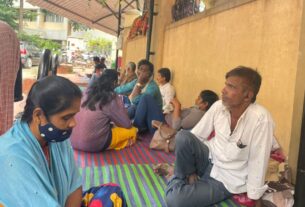Male-oriented transport policies and lack of inclusive work conditions lead to less representation of women in the BMTC.
Bengaluru: Working for more than ten hours a day, not being able to see her family, facing harassment from commuters and her employers, and being surrounded by mainly male employers. This is the ordeal of Kusuma Omprakash, a woman bus conductor with the Bangalore Metropolitan Transport Corporation (BMTC). None of this has changed since 1999.
In BMTC, there is only one woman driver and only 1486 out of 24246 conductors are women, said Bhagyalakshmi, District Transport Officer. “Even if women want to get a job as a driver or a conductor, it is difficult because of the number of problems we face,” said Omprakash.
According to the International Labour Organisation (ILO), only 6.85 percent of women were employed in the transportation sector in India in comparison to 19 percent of men in 2005. The report notes that employment opportunities in the transport sector and access to transport services are “highly gendered”.
In fact, the Institute for Transportation and Development Policy recommends that at least 50 percent of women should be employed at junior, middle, and senior management positions across different functions such as drivers, conductors, depot managers, urban and transport planners etc. The report notes that if women’s presence is created at different levels in public transport, it would help with bringing women’s issues to the forefront. However, the representation of women in BMTC has been less with women conductors forming only six percent of the total number of conductors, said Bhagyalakshmi.
Additionally, one of the goals under the Sustainable Development Goals is to ensure gender equality and empower all women and girls. The goal recognises that while women played an important role as first responders during the Covid-19 crisis, they still remain underrepresented in critical leadership positions.
One of the reasons for such less representation is that the working conditions in the transportation sector are not inclusive of women’s needs, said Genesia Rodrigues, a member of the Bengaluru Bus Prayanikaara Vedika (BBPV). “There are shift problems as some women bus conductors are called for overnight shifts. In such situations, it is difficult for women to reach the depots from their house,” she said. Additionally, they are made to work for longer hours which could bring challenges while fulfilling their other responsibilities at home, she added.
While Kusuma worked for eight hours before the pandemic, she now works from 8 am to 7 pm (more than eight hours) in one day. “I do not get to see my kids and family at home for a really long time,” she said. I try to not drink water properly as well because I cannot find clean toilets at every route that I drive in, she said. This is causing more reproductive health problems for many of us women conductors, she added.
“We asked for leave during our periods but we do not get that as well,” she said. In fact, the authorities also deploy us at routes that are far away from our house which makes it difficult for us to travel, she added. Additionally, women conductors face harassment from commuters as well, said Rodrigues. Several reports have pointed out that BMTC’s only female driver, Prema Nadabatti was harassed and beaten in front of the passengers in 2016.
More representation of women in the transportation sector will play a larger role in addressing such issues as women safety, their health, their family’s needs etc, said Paati, a gender activist and researcher. “Most of the time, policies designed for a particular community do not include people from that community in the decision-making process,” she said. Such policies do not make any sense, she added.
There is a general lack of awareness about women’s mobility patterns and how women use the city, said Sneha Visakha, an urban development researcher. “While women are the main users of public transport, the transport infrastructure doesn’t meet the concerns of women,” she said. Bus stands and shelters do not have the proper sanitation facilities and women are usually made to wait long hours just to use the washroom, she added.
Additionally, women conductors said that they are not comfortable with their uniforms. “We have been demanding some sort of suit but we are only given sarees. How are we supposed to stand in an overcrowded bus and do our job in sarees?” asked Omprakash. If we ask for anything that is against their specific rules and regulations we just get suspended, she added.
Some researchers said that although there is a good contribution from women in jobs such as cab drivers, metro drivers and conductors, compared to how it was a few decades ago, it is still not enough. In fact, leadership and decision-making in the transportation sector has always been considered as something that only men know how to do, said Paati. “For many years, the decision for a woman to take a bus to reach someplace has also always been taken by men,” she said. As a result, transport policies also end up being designed for men, she added.
For example, the BMTC in 2019 had decided to install CCTV cameras in around 1,000 buses and 38 bus stations under the Nirbhaya scheme. However, researchers point out that it cannot be the only solution to ensuring women’s safety. “The real question is who is monitoring these cameras and how many of them are going to be deployed,” said Visakha. Women’s perspectives need to be included in transport planning, she said. People from the community need to be involved in the decisions that are being made for their benefit, she said. “Otherwise women will be forced to walk long distances and their access to economic opportunities will be limited,” she added.




